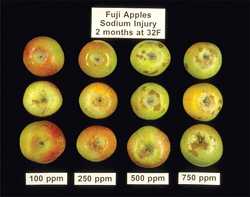How to Identify Apple And Pear Storage Disorders

Storage Scald
Storage scald (also called superficial scald) does not usually develop until after approximately two months in regular cold storage. The symptoms are light to dark-brown discoloration of the peel in patches around the fruit surface but especially at the blossom end, and occur when a disruption in fruit metabolism at cold temperatures leads to oxidative damage and the death of some surface cells. It can be distinguished from sunburn because it is spread around the surface of the fruit rather than on one side and does not include any yellow discoloration with the browning.
In severe cases of storage scald, the peel becomes wrinkled in appearance. Fruit grown in hot, dry climates are more susceptible and there are also differences between cultivars in susceptibility. Granny Smith and Red Delicious are very susceptible, while Fuji, Gala, and Pink Lady are much less susceptible. Fruit harvested when they are less mature are also more likely to develop this disorder.
Storage scald can be controlled by treatment with diphenylamine (apples) or ethoxyquin (pears). Both of these materials are antioxidants that prevent the oxidative damage that is characteristic of storage scald development.
The development of storage scald can be delayed for many months by storing the apple or pear fruit under controlled atmosphere, especially when oxygen concentration is less than 1.5%. Treatment of apples with SmartFresh at harvest also controls storage scald. This treatment also works for pears, but one should be cautious about using SmartFresh on pears to assure the fruit will ripen when required for marketing.
Bitter Pit
Bitter pit develops within the first one to two months of cold storage. Sometimes it is present at harvest. The symptoms of bitter pit are dark-brown spots on the surface or just below the surface of the peel. Generally these spots are sunken in the center. The flesh under bitter pits is brown and corky (dry and spongy) in appearance. Bitter pit is related to a low calcium content in the fruit tissue at harvest which results in leakiness of the membranes and eventual death of cells in localized areas. The pits are most common on the blossom end of the fruit, but can occur all over the fruit surface.
Bitter pit is best controlled by regular calcium sprays in the orchard. As many as 10 or 12 weekly sprays of calcium can be applied; however, in some seasons this will not completely prevent bitter pit from developing but should reduce its incidence. There are definitely seasonal patterns to bitter pit susceptibility, but the reasons for this are not yet known. Drenching the fruit in a calcium solution after harvest can help to increase the calcium content of the fruit, especially in the peel; however, this is generally less effective than the field sprays.
Sodium Burn
Apples that have been pre-sized or otherwise exposed to water solutions sanitized with liquid chlorine (sodium hypochlorite) prior to cold storage can develop peel browning symptoms from sodium burn. The damage can often be seen in the calyx bowl where liquid can collect, but can also be seen on the shoulders of the fruit or any place the skin is cracked.
Sodium burn occurs when water systems have been used for several days with regular additions of liquid chlorine to maintain an effective residual chlorine level or oxidation reduction potential (ORP) level for sanitation. The sodium portion of the sodium hypochlorite accumulates in the water systems and can quickly approach damaging levels. As little as 100 parts per million of sodium can eventually cause peel browning on apples, depending on the cultivar. Gala and Fuji appear to be very susceptible, but Granny Smith is also susceptible. Pears are even more susceptible to sodium burn.
This type of injury usually does not appear until the fruit has been in cold storage for several weeks. Damage can be prevented by replacing the water frequently when sodium hypochlorite is used, by using a non sodium-based sanitizer (calcium hypochlorite, ozone, chlorine dioxide, etc.), or by adding a fresh water rinse following removal of the fruit from the water system.
For more information, visit http://postharvest.ucdavis.edu/Produce/Producefacts/index.shtml.










